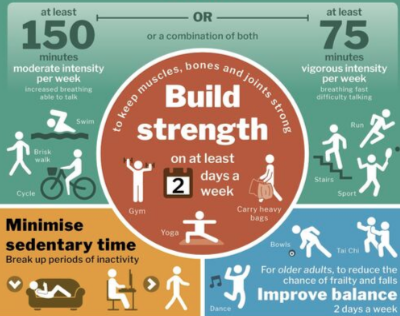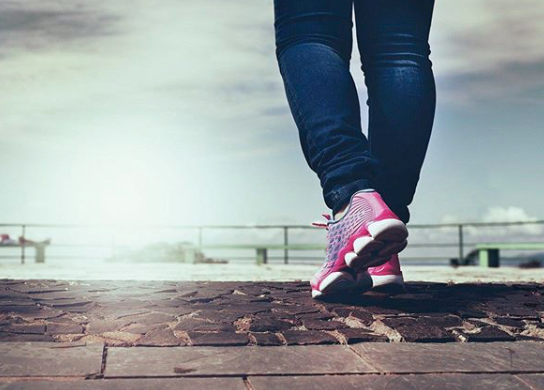Guest Author, Kassi Schuppe, PT, DPT, CSMT
COVID has impacted all of us in some fashion and it likely has changed your routine or your ability to stay active during this time, due to gym closures, closing of pools, cancellation of events, etc. However, this time has definitely impacted those 65+ years of age or those that are at high risk due to other medical conditions. Today, I would like to discuss why it is important for us to be physically active, how much physical activity is recommended, and also provide you with 5 tips on how you can stay active during this time and beyond.

Benefits of Physical Activity
Being physically active, has a number of important health benefits including but not limited to:
- Decreased risk of all-cause mortality
- Decreased risk of disease
- Improved quality of life
- Improved cardiovascular health
- Improved quality of sleep
- Improved mental health
- Increased physical function
- Decreased risk of falls
- Maintain mobility and independence
Key Physical Activity Guidelines for Older Adults
- For substantial health benefits adults should do at least 150 minutes of moderate intensity or 75 minutes of vigorous intensity physical activity per week
- Additional health benefits are seen beyond 300 minutes per week
- Perform muscle strengthening activities of moderate or greater intensity 2 or more days per week
- Move more and sit less throughout the day
- Some physical activity is better than none
- Start with small changes to your activity level and increase as you become more physically fit
|
Examples of Physical Activity and Intensity Levels |
|
Moderate Intensity Activities
|
|
Vigorous Intensity Activities
|
What Does This Mean for You?
Some activity is better than no activity and the positive effects of physical activity compound as you exercise more. If you are currently an inactive person, don’t worry, all you have to do is start small, but it is important that you start being physically active. One study has shown that with as little as one hour of walking per week, women reduced their risk of cardiovascular disease. One single session of moderate-vigorous exercise can decrease blood pressure (BP) and anxiety and improve insulin sensitivity, sleep, and cognition for up to 12-16 hours after exercise. And the even better news is that these improvements become greater and the effects become permanent with regular exercise.
If you are currently a physically active person, even a slight increase in the intensity or amount of physical activity you do can show a positive effect on your health. A small increase in energy expenditure can improve your mortality risk by 20%. So no matter where you are in terms of your level of physical activity, making small changes today can have a big impact on your future.
5 Tips on Staying Active During COVID and Beyond!
- Incorporate Activity into Your Daily Routine
- Routines are important and having a consistent routine will help you start incorporating activity into your day. Some examples would include: perform a morning stretching routine, take a morning and evening walk, or carve out 15-30 min per day specifically for an exercise routine.
- Take advantage of down time. For example, walk around the house or perform an exercise like marching in place, squats, push-ups during commercial breaks. Yes, all these exercises can be modified to your physical ability. If you like to read or be on the computer, make sure that you take frequent breaks, at least every half hour to get up and walk, stand, or stretch for at least 5 min.
- Double down on things you are already doing during the day. If you have to go downstairs to do your laundry, take an extra trip or 2 up and down the stairs, every time you get up from a chair perform 5 squats to the chair, add an extra block to your walk, park farther away at the grocery store, etc. These small changes over the course of a week can really add up to increase your overall activity level.
- Take Advantage of Free Resources
- There are plenty of free resources and a lot of them are at our fingertips thanks to the internet. YouTube is a great resource and there are a number of videos that can lead you through exercise routines specifically for older adults.
- There are a number of different internet resources as well, I have included 2 below.
- Make sure to take advantage of resources within your community at senior centers, local YMCAs or gyms with activities or programs specifically for older adults. Also, make sure that if you live in a retirement community, assisted living facility, or apartment with a gym, that you take advantage of this amenity.
- What Benefits Does Your Employer or Insurance Company Offer
- If you are still working, your employer may have a specific health and wellness program or your insurance may also have benefits to help with physical activity or rewards for keeping up with your health and wellness. If you are retired, make sure to read through your insurance benefits, both Medicare and your supplemental policies to see if they offer any free resources or assistance in helping cover the cost of gym benefits or other physical activity programs.
- Enjoy the Benefits of Nature
- Being outdoors decreases your risk of exposure to COVID, especially when maintaining 6ft of physical distancing, compared to an indoor setting, so getting outside to go for a walk, bike ride, or doing yard work is a great way to stay active. Plus nature has additional health benefits.
- Nature can also contribute to your physical well being by reducing blood pressure, heart rate, and production of stress hormones. Being in nature can reduce anger, fear, and stress and increase pleasant feelings, which is an added benefit to also being physically active.
- Get an Accountability Partner or Group
- Having an accountability partner and group, even if done virtually can help increase your compliance and consistency with being physically active. Having someone to workout with is also more fun and enjoyable than doing it on your own. Also, knowing there is somebody counting on you helps increase your motivation, and sharing a common goal helps you be consistent and accountable to one another.
What to do Next
Make the choice to take the next step and either start being more physically active or make it a point to increase your current level of fitness. It does not need to be a daunting task, just start small by moving more and sitting less. Then increase your physical activity as you become more physically fit. If you are not sure where to start or you have other medical conditions or aches and pains that you feel are limiting your ability to be physically active, then consult with a trained physical therapist or other healthcare professional to develop a program to meet your specific needs.
About Kassi Schuppe, PT, DPT, CSMT
Kassi is the sole owner and practitioner at Enhance Performance Therapy in Clive, Iowa. Kassi moved to Iowa to attend Physical Therapy School at Des Moines University where she graduated with her Doctorate of Physical Therapy in 2014 and was named the Graduate of Distinction. She has been practicing in the area of orthopedics since graduation with specializations in sports rehabilitation and manual therapy. She understands the frustration of having aches/pains or injuries getting in the way of doing the things you love. Kassi wants to help you maintain your active and healthy lifestyle and not miss out on the things you enjoy most.
Kassi is married to her wife, Aimee, and they have two daughters, Anna and Brittany. They also have 2 dogs, Peyton and Denver, and 1 cat, Oliver. Outside of work, Kassi loves spending time with her family, working out (specifically Olympic Weightlifting), hiking or any outdoor activity, and during football season she never misses a Denver Broncos game (hence the dogs’ names).
DISCLAIMER: All content found at happyathomeconsulting.com was created for general informational purposes only. The content is not intended to be a substitute for professional advice, diagnosis, or treatment. Always seek the advice of your physician or other qualified medical professional with any questions. Each person’s medical and occupational therapy needs are unique. Never disregard professional medical advice or delay in seeking it because of something you have read or seen online.


